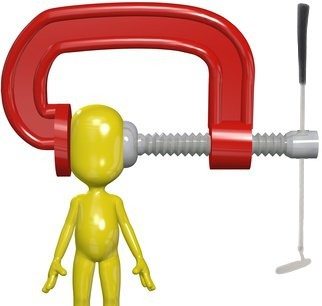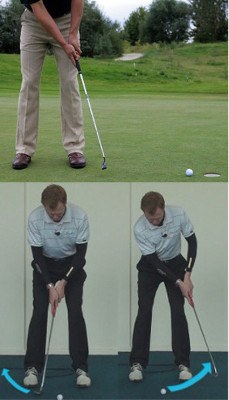
Most golfers have an easier time getting the ball from tee to green, but getting their scores lower comes down to the number of putts. Here're some tips to help you putt better, especially when under pressure:
• Have a good routine entrained in your mind. You'll be surprised how well it can carry you through those high-pressure situations.
• Tireless dedication to practice will train muscle memory to help your stroke hold up under pressure.
• To be a consistent putter under pressure, always remember to keep your head still.
• For most golfers, having wrist movement in your putting stroke is a style that will not hold up well under pressure because the extra moving parts of the wrist require more coordination and timing. Wrist movement reduces control of distance and direction during the stroke, often causing those 3-4 foot putts to be missed when under pressure. Try instead to develop a big muscle pendulum stroke (shoulders, and arms moving together in a rocking motion), which will hold up much better under pressure.
• Select a putter that looks good to your eye. This will give you more confidence when facing the pressures of putting.
• Select a custom putter that fits you properly. This will help your muscles to be relaxed and without tension before the stroke.
• There are at least 3 different putter styles to choose: traditional, mid-length (belly), and long. Select the putter style that gives you the most confidence, stability and helps you relax under pressure.
Thomas Golf Putters
Traditional, Mid-Length/Belly & Long Putters

How to Putt Under Pressure
When standing on the practice green, putting can seem pretty easy. After all, your ball may only be a few feet from the hole, and there is nothing between you and the target but short, smooth grass. As long as you roll the ball in the right direction, it can't help but fall to the bottom of the cup. Nothing to it, right? During practice, it might feel that way. However, out on the course, it is another story entirely. When you add pressure to the equation, suddenly what once seemed like an easy putt can become an enormous challenge. To record low scores, you not only have to be able to putt well in practice – you also have to be able to get the job done when the heat is on.
In this article, we are going to look at a variety of topics related to the central theme of putting well under pressure. Making putts when the pressure is on is one of the toughest tasks you will face as a golfer, and it is one which you can't avoid. Even if you don't play in golf tournaments, you are still going to feel pressure when trying to set a new personal best score, or when trying to make a putt for birdie or eagle. You will be rewarded with a great feeling when you do drain a tough putt under pressure, but there is plenty of work to be done before you can get to that point.
The challenge of putting when the heat is on includes both physical and mental components. We are going to touch on both sides of the equation in this article, as you will never get far if you only have one of the two in place. You have to have the right fundamentals in your stroke to make pressure putts, but you also need to have your mind in the right place as well. Many golfers overlook the mental side of their game as they practice, thinking that good technique is good enough to get the job done. That simply isn't true in golf. Technique is great, but it won't go far without the ability to control your thoughts and emotions as you play.
Of course, if you are going to putt better under pressure, you have to be willing to practice your putting in the first place. Putting is consistently ignored by the average amateur golfer who would rather slam driver after driver down the range. If you would like to make progress in your game, and get ahead of your competition at the local club, trade out some of your range time for more repetitions on the putting green. The short game is really where you will find the ability to save strokes, so time spent on and around the practice green is a wise investment.
All of the instruction below is written from the perspective of a right-handed golfer. If you happen to play left-handed, please take a moment to reverse the directions as necessary.

Problems Caused by Pressure
At first, it might seem like it would be easier to putt under pressure than it would be to hit a long drive down the middle of the fairway. You need precise timing to hit an accurate drive, or even a great iron shot, and it would seem like nerves could get in the way of such timing. And of course, it is true that pressure can cause problems with your full swing. However, those problems pale in comparison to what can happen to your putting stroke.
Since the putting stroke is such a delicate, precise action, even a small reaction to pressure can cause your putt to miss the mark. The list below includes some of the common ways in which pressure can lead to major trouble on the greens.
- Difficulty with speed control. When putting from a long distance away, you might find that your speed control is not as precise under pressure as it would be otherwise. This is because you have lost feel for the putter as it swings. Your hands are likely tight while you are nervous, and the muscles up into your arms and shoulders may be tight as well. Without the ability to let the putter flow freely through the ball, your stroke will be forced and distance control will likely be off. It might not always be possible to relax yourself completely before hitting an important putt, so you are going to need to learn how to control your speeds even when you feel nervous. We will touch on this topic more later in the article.
- The yips from short range. Pretty much every golfer in the world has experienced some form of the yips at one point or another. The 'yips' refers to a mistake you make when putting from short range, where your hands and the putter move violently just prior to impact. The ball is almost always sent off line as a result of this action, and it may be hit too hard as well. The yips are a particularly frustrating problem to deal with because they can pop up at the worst time. For instance, you could hit a brilliant approach shot to within just a couple feet of the hole, only to have the yips get in your way of making the birdie. It is possible to struggle with the yips at any time, but they are far more likely to appear when the pressure is on.
- Quick putting tempo. The tempo you use during your putting stroke is just as important as the tempo you use with your full swing. Even if you have a great tempo built into your stroke, you might find that it gets lost when you become nervous. Most golfers, when nervous, will speed up their actions. On the greens, this can be seen in a couple of ways. First, you might not take as much time reading your putt as you would in a less-pressurized situation. Also, the stroke you make may be quicker from start to finish. In a hurry to get it over with, you could rush through the stroke hit a poor putt as a result. Obviously, if you are going to manage to succeed when putting in a pressure situation, it will be crucial to slow yourself down to your usual pace.
No one likes missing putts under pressure. It is a terrible feeling to see the ball roll past the side of the cup, knowing that you would have made it if not for the pressure you were feeling inside. Fortunately, there is another side to this equation – the great feeling you get from succeeding under pressure. If you step up to a putt is an important moment and knock the ball right into the middle of the cup, you will ride high on that feeling for many holes to come. By using the tips provided throughout the rest of this article, you should be able to enjoy the feeling of succeeding under pressure more than ever before.

Pressure-Proof Mechanics
The first thing you need to do in order to putt your best in big moments is to design the mechanics of your stroke with pressure in mind. There are a few specific bits of your technique which should be formulated specifically to deal with the pressure you are inevitably going to find on the course. If you currently have a putting stroke which works well in practice but poorly on the course, there is a good chance that your mechanics are not well-suited for performance in the clutch.
As you refine your putting technique during upcoming practice sessions, keep the following mechanical points at the front of your mind.
- Quiet hands. This is the most important point of all when it comes to putting under pressure. If you are going to roll the ball accurately toward the hole time after time – even under pressure – you need to keep your hands out of the putting stroke. Your hands and wrists should not be doing anything at all while the putter swings. Sure, your hands are holding onto the grip of the putter, but that is where their involvement comes to an end. The putter should be put into motion by your shoulders as they rock back and forth. If you can manage to move the putter just by moving your shoulders, you will be able to make an incredibly smooth and repeatable stroke. Not only will your stroke perform well under pressure when you use this technique, it will simply be more reliable overall. The best golfers in the world work hard to keep their hands out of the putting stroke, and you should be doing exactly the same thing.
- Flex in your knees. You need a stable base if you are going to putt well under pressure, so make sure your knees are appropriately flexed at address. The exact amount of flex you use is up to you, but make sure it is enough to engage the big muscles of your lower body in the stance. If you were to stand straight-legged over the ball, you would be likely to move all around during the stroke – and extra movement is no way to putt well when the heat is on. Sit down into your stance firmly and stay there the entire time the putter is in motion.
- Keep your head perfectly still. You have probably heard that you need to keep your head still while putting, but this point is particularly important when trying to sink putts under pressure. It's important to highlight this point with regard to this topic because you are going to be more inclined to move your head when the stakes are high. For instance, if you have a short putt to win a match at your local club, you will be tempted to look up early to see if the ball is on line. Of course, doing so is only going to decrease your chances of actually making the putt, so you need to be committed to keeping your head down and still. Lock your eyes on the top of the ball at address and stare at that spot until the ball rolls away. As your reward for keeping your head perfectly still, you should make a much higher percentage of your pressure putts in the months and years ahead.
- Light grip pressure. This point is often overlooked during putting practice. It is an important point with regard to putting while nervous, however, as light grip pressure is going to help you maintain your feel for the speed of your putts. If you are squeezing the handle of the putter tightly as you make the stroke, it will be almost impossible to get your speed right. By relaxing your grip, you can restore some of the feel in your hands and you will be able to roll the ball out toward the cup with much greater control of the pace. Since you don't have to swing the putter very hard in order to send the ball toward the hole, you should be able to use an extremely light grip while still keeping the club in your hands.
If you can manage to successfully hit on the four points listed above within your putting stroke, you will be well on your way to excellent results. Not only will you putt better in big moments, but you will simply putt better overall.

The Right Mindset
With the technical details out of the way, it is time to deal with the topic of your mindset on the greens. Even the best putting stroke in the world isn't going to take you very far if you aren't thinking clearly and rationally as you putt. Perhaps more than anywhere else on the course, your mind needs to be an asset while rolling putts toward the cup. Unfortunately, many amateur golfers are a bit of a mess when it comes to the mental side of putting. Negativity abounds, and that is a shame. If you are willing to work hard on turning your way of thinking around, the results may shock you.
What does a good putting mindset look like? The following points are a great place to start.
- Expect success. When you stand over the ball to hit a putt, you should expect to see it roll in the middle of the hole when all is said and done. There is no reason to think any other way – planning on failure is only going to take your mind in the wrong direction. You need to have as much confidence as possible when hitting your putts, and thinking only about being successful is going to leave you in a positive frame of mind. Sure, you know that you aren't ever going to make all of your putts, but that doesn't mean you can't plan on success. Picture every putt you hit diving into the cup and they just might start to fall in more frequently than before.
- Accept failure. This might seem like a weird point to include on this list. If you are going to expect to make all of your putts, why would you be okay with a miss? Simple – you have to be accepting of failure because it is inevitable. You are unlikely to ever play a single round of golf where you make each of the putts you attempt. Missing putts is part of golf, so you can't allow yourself to get too upset when it happens. Even if you make a great read and a great stroke, you can still miss the putt if your ball hits a bump on the green, or if a gust of wind comes up and alters its path. Since the ultimate result of each putt is not necessarily in your control, it would be silly to blame yourself for every miss. Do your best on each putt, expect to be successful, but understand logically that some of your putts are going to slide by the edge.
- Take your time. The amount of time you take prior to hitting a putt comes down to the mindset you take with you onto the green. Are you just trying to get your putt over with as quickly as possible, or are you willing to work hard in order to knock it in? If you are only wanting to get it over with so you can stop feeling nervous, you are going to rush yourself and you will likely miss. You need to be willing to invest some time in preparing to hit a great putt if you want to succeed more than you fail. Nobody likes a slow golfer, but it is no fun to miss all of your putts, either. Take an appropriate amount of time to read your putt and plan your speed before you send the ball on its way. As long as you are focused on the task at hand, you should be able to get all the information you need without bringing the pace of play to a halt.
- Focus, focus, focus. One of the problems faced by many amateur golfers when they reach the green is the fact that they are reunited with the other players in their group after walking up the fairway. At this point, you might be tempted to tell another player about your approach shot, since they might have been off dealing with their own ball at that time. There is nothing wrong with some chatting on the course, but you shouldn't let it get in the way of your ability to focus on the task at hand. Feel free to chat, but return your focus to the job of making a putt when it is your turn to play.
Just as with everything else in golf, you have to learn how to think properly in practice before you can do so on the course. Pay attention to how you are thinking about your putting when you are on the practice green keep refining your mental approach until you are happy with your state of mind while the putter is in your hands.

Build a Lasting Relationship
This last point we are going to make has to do with the equipment you use on the greens. Of course, that means your putter. One of the commonly seen mistakes in amateur golf is the tendency to switch putters after just a round or two of poor performance. Since new putters are so easy to purchase, and used putters are available all over the web, you might be tempted to fire your current putter after a rash of three putts – or even a case of the yips. While it is easy to blame your putter instead of yourself, getting rid of your putter is rarely the answer to your problems.
In fact, you should be doing just the opposite. Rather than ditching your putter at the first sign of trouble, you should instead be sticking with the putter through thick and thin for as long as possible. By staying with the same putter as years go by, you will develop a trusting relationship with that club. You will know exactly how the ball comes off the face, and you will have a feel for your putts which leads to tremendous confidence. Resist the temptation to buy new putter after new putter and you will be on the path to a successful putting future.
It is hard to putt well under pressure. There is no debate to be had on that point, so you might as well accept it and begin to look for ways to perform better on the greens in spite of your nerves. Once you have a plan, the practice green is the only place to make any real progress toward your goal of becoming a better putter. Good luck!






